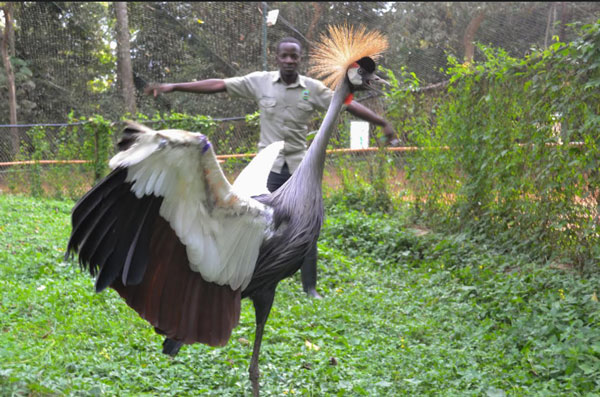
As its habitat disappears due to human encroachment on Uganda’s wetlands, the gray crowned crane has moved to farmland in search of food. That’s a problem.
Lwengo, Uganda | Apophia Agiresaasi – Global Press Journal Uganda | Looking at the gray crowned crane, it’s not difficult to see why it appears at the center of Uganda’s flag. Thin spikes that look like a golden crown cover the bird’s head. Its feathers, in shades of gold, black, white and brown, elongate to form an ornamental fringe. All those features, combined with a long neck and slender black legs, give the bird, also known as the crested crane, an elegant look as it majestically forages across the wetlands, where it spends most of its time.
Across the country people have a cultural attachment to the crane, says Jimmy Muheebwa, the project manager of Nature Uganda, an organization dedicated to protecting birds and their habitats. It is the totem of the Bahinda clan of western Uganda and of clans in the central part of the country, where it enjoyed the protection of the king of the Ankole kingdom. This cultural attachment included such beliefs that if one killed a crane, the birds would hold vigil at the killer’s home and mourn until the killer went mad or even died.
“Such stories instilled fear, and cranes would be revered and not killed,” Muheebwa says.
“The gray crowned crane is fabled for its gentle nature and was also the military badge of Ugandan soldiers during British rule. The raised leg of the crane symbolizes the forward movement of the country,” he adds.
But this revered bird has recently become the subject of a conflict. The wetlands it calls home are disappearing, as the increasing human population and urbanization demand the conversion of wetlands into fields for agriculture, consequently reducing the bird’s population. And while a law protecting the bird exists, experts say the government has yet to properly implement it.
From 1994 to 2020, the area of Uganda covered by wetlands decreased from 15.5% to just over 8% and could fall to just 1.6% by 2040 if the current trend continues, according to a brief by the Ministry of Water and Environment.
This depletion of wetlands has forced the gray crowned cranes to move to farmland in search of food, putting them in conflict with farmers who kill them, reducing their numbers, Muheebwa says.
Bashir Hangi, the communications manager for the Uganda Wildlife Authority, says the current gray crowned crane population in the country ranges from 15,000 to 22,000, a steep decline from about 35,000 counted in a 1995 census.
The destruction of their habitat has greatly threatened the birds’ existence, says Rogers Nuwamanya, the landscape manager of Fauna & Flora International Uganda, a conservation organization.
“We used to see gray crowned cranes roost on trees,” he says. “Lately, you rarely hear their sound. Either their numbers have reduced, or they have migrated where the habitat is still stable.”
Farmers like Lawrence Ntare, from Lutooma in Lwengo district, say they have had a turbulent coexistence with this bird of national significance. Ntare says he never kills them, but he hires at least three people per acre and pays each 20,000 Ugandan shillings (about $5) a day for at least four days to guard his planted seeds so they can germinate. This is an additional unplanned expense, but Ntare, whose farm is near a wetland, says he has no other option.
“We always have to chase these gray crowned cranes from our gardens,” he says. “I grew up knowing the crested crane is not supposed to be killed. So, I just chase them, but I have never killed one.”
It’s not only conflict with farmers that has endangered the gray crowned crane. The bird is also hunted for use in traditional medicine. Francis Emeru, a traditional healer who says he uses herbal medicine to treat ailments, says the decline in the bird’s population can be tied to “witch doctors” who claim to speak to the gods and to cure diseases or improve people’s fortunes using body parts of animals like the gray crowned crane.
“They might tell people, ‘If you get me body parts or feathers of a crested crane, you’ll get rich.’ Or, if you are a woman, ‘Your husband will never leave you,’” Emeru says. “Hence, many people are found looking for crested crane eggs and chicks or other body parts to take to witch doctors.”
Although the government passed a law, included in the 2019 Uganda Wildlife Act, that grants life imprisonment or a fine of 200 million shillings ($54,372) for anyone caught killing or known to have killed the gray crowned crane, Nuwamanya says it has yet to have any impact.
“They need to come up with guidelines and regulations and raise awareness about the law before it can be effective,” he says. “Understanding the importance of the bird species will have more impact than policing using the law.”
Eric Ntalo, the public relations officer at the Uganda Wildlife Conservation Education Centre, which rescues wild animals and educates people on their importance, agrees about the need to teach communities to use the wetlands sustainably.
“It’s our emblem, and we have a lot to learn from it,” Ntalo says of the gray crowned crane. “It’s a totem for some tribes in Buganda.” He adds that the Uganda Wildlife Conservation Education Centre has been educating communities to protect the crane.
But the Uganda Wildlife Authority is already implementing the law, says Hangi, the communications manager. He says authorities have arrested, prosecuted and imprisoned people caught killing the birds, though he wouldn’t say how many. The wildlife authority has also initiated an action plan that lays down guidelines on how to protect the national bird and is working with partners such as the International Crane Foundation, which is conducting advocacy and sensitization campaigns. “Sensitization continues, it never ends,” he says.
Nuwamanya says he sees another area where the institutions meant to protect the birds are slacking. Environmental officers who are supposed to make sure locals don’t encroach on the wetlands through regular inspections lack the resources to operate adequately, he says.
“You find in a whole year they have a budget of 500,000 shillings [$136] to safeguard all wetlands in the district,” he says.
Global Press Journal contacted several environmental officers for comment, but they did not respond to requests.
Farmers can find a way to coexist with the national bird, says Ntalo. Instead of destroying wetlands, they should have ecotourism projects, which would ensure they profit from the wetlands without destroying them, so cranes can still use them as habitat. Since they have local knowledge about the famed bird and the wetlands, they could make money acting as guides instead of destroying the wetlands, Ntalo says.
Although Ntare sees this as an alternative way for farmers to earn money, he says they need help to gradually change their practices.
******
This story was originally published by Global Press Journal (link).
Apophia Agiresaasi, GPJ, translated some interviews from Luganda.
*****
✳ Global Press Journal is an award-winning international non-profit news publication that employs local women reporters in more than 40 independent news bureaus across Africa, Asia and Latin America.
 The Independent Uganda: You get the Truth we Pay the Price
The Independent Uganda: You get the Truth we Pay the Price



